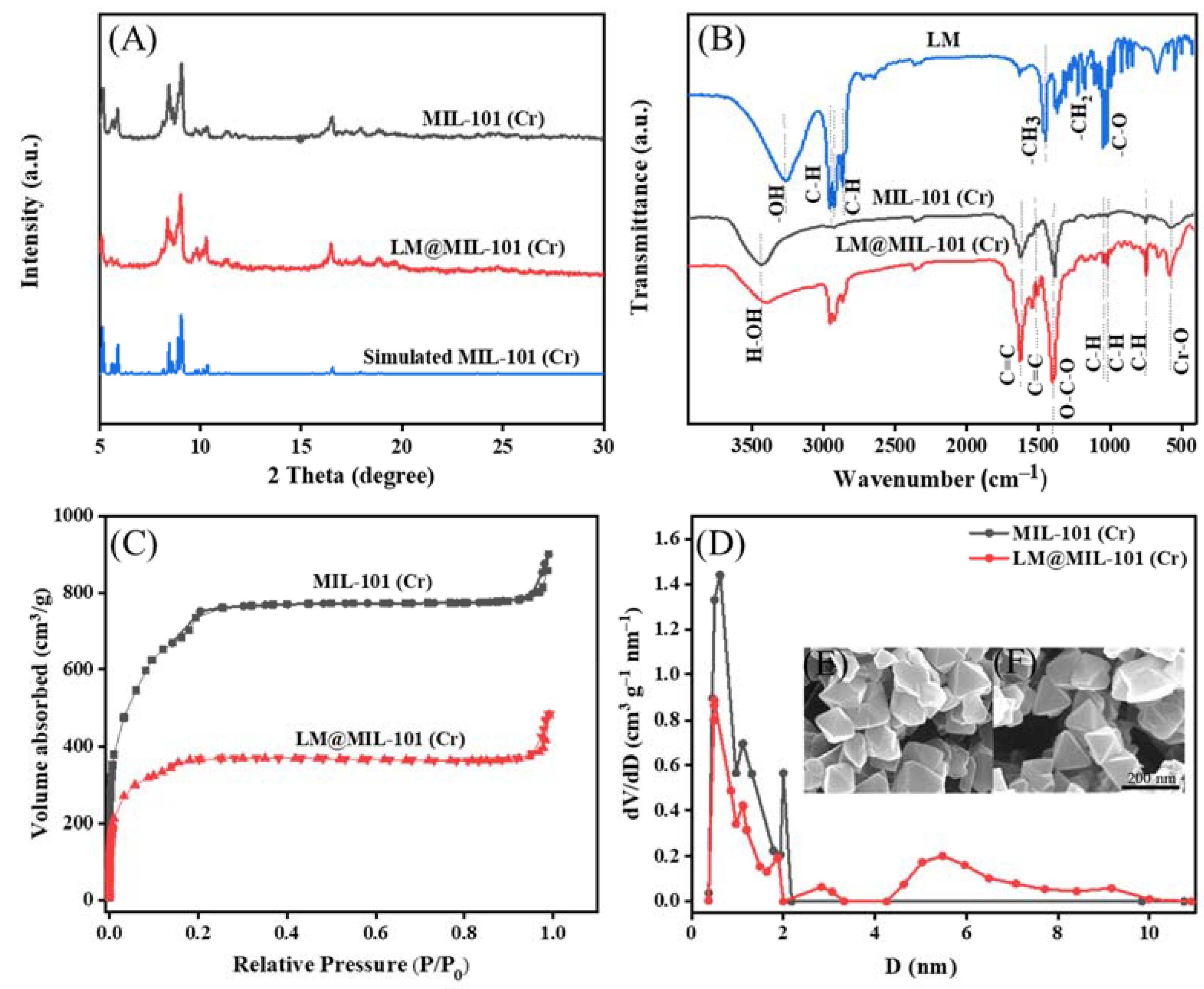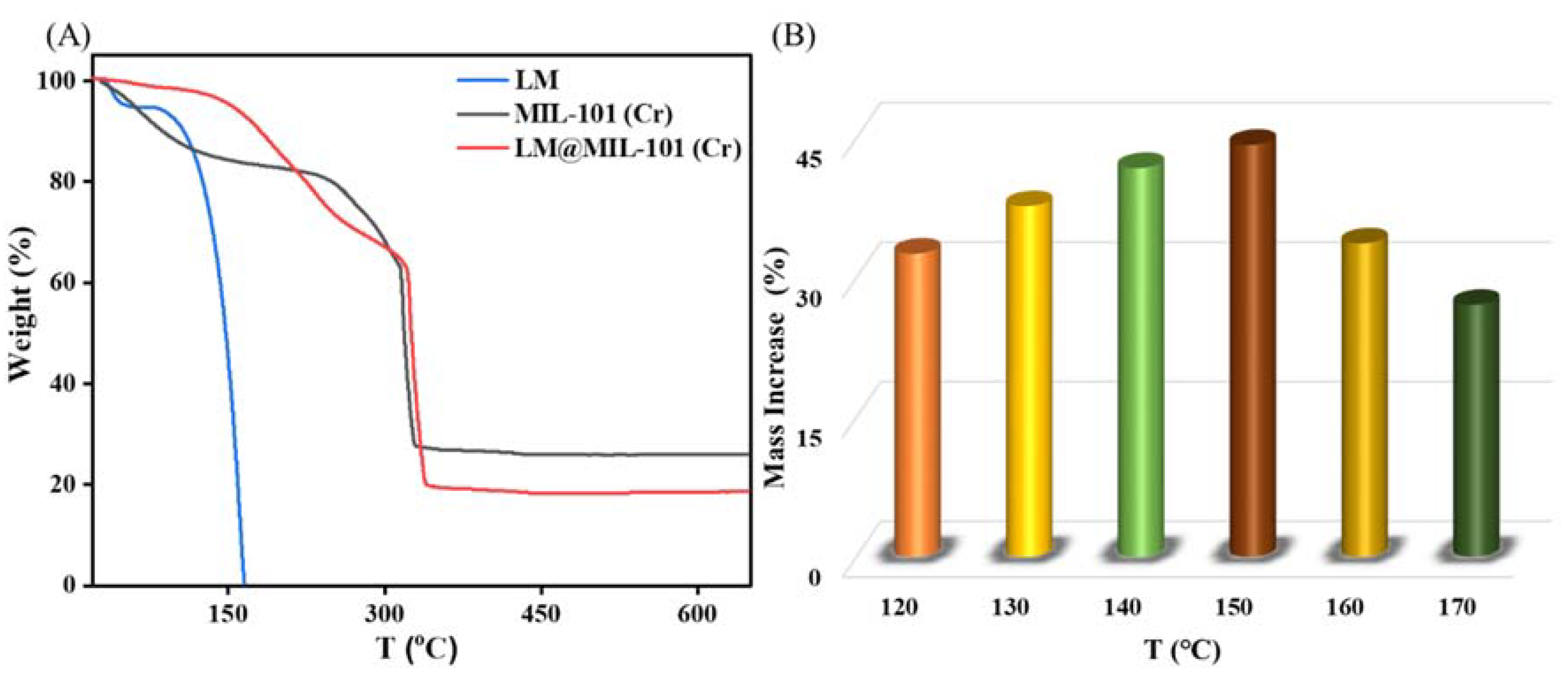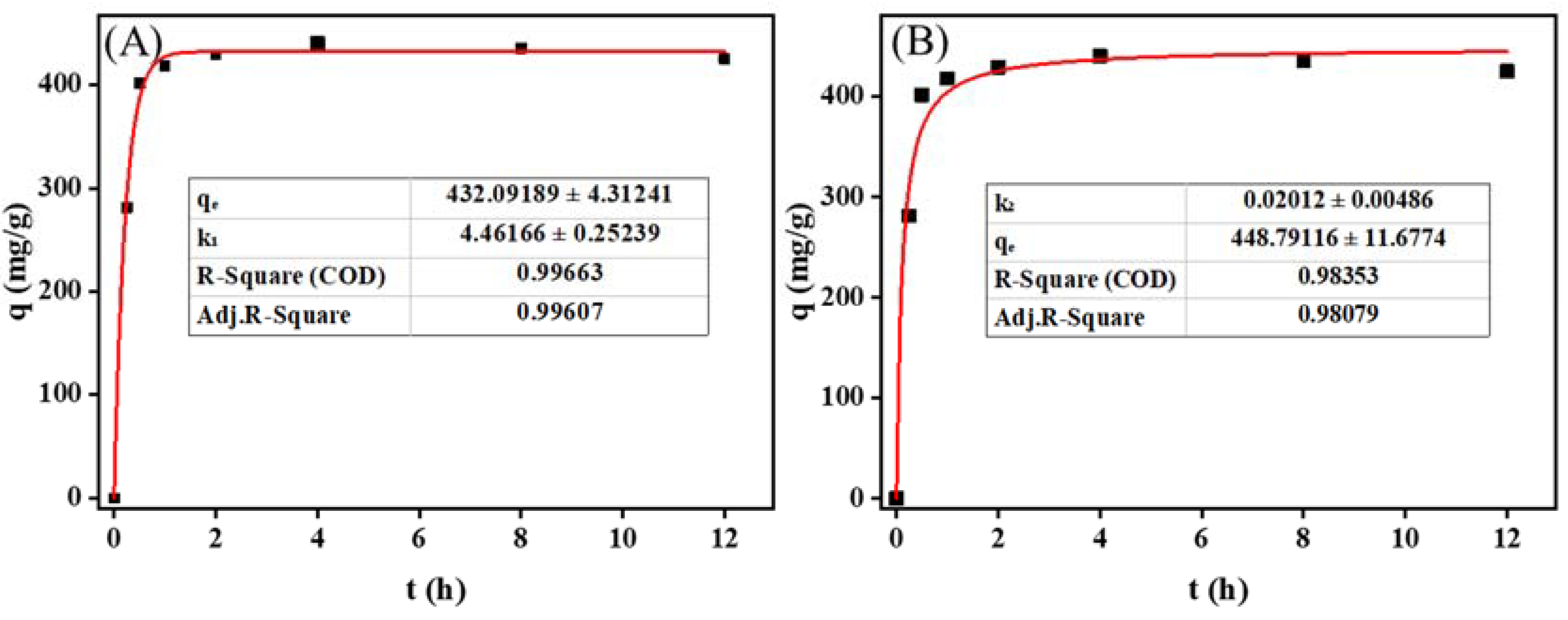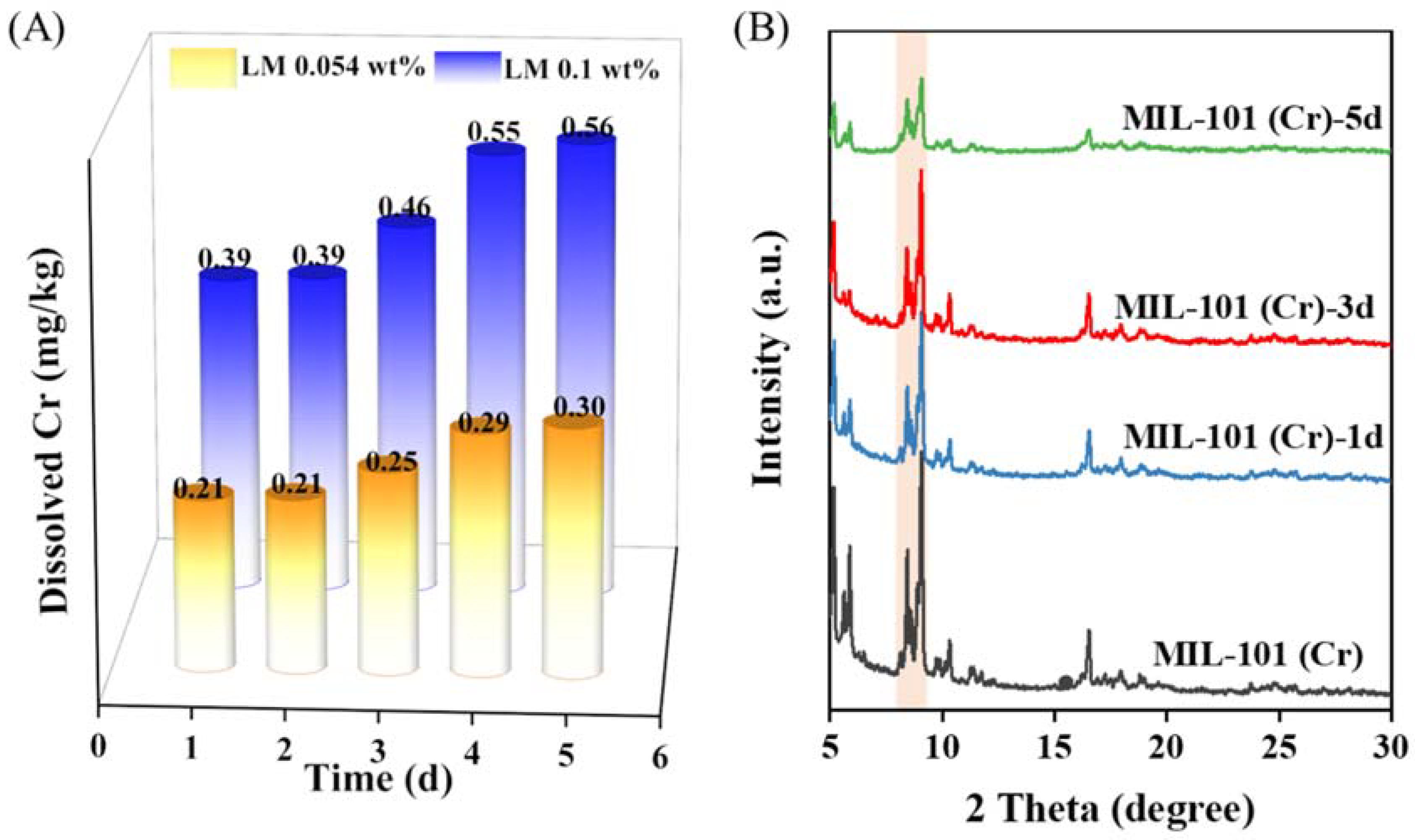Controlled Thermal Release of L-Menthol with Cellulose-Acetate-Fiber-Shelled Metal-Organic Framework
Abstract
:1. Introduction
2. Results
2.1. Physicochemical Characterization Analysis
2.2. Adsorption Kinetics
2.3. Heat-Release Property Analysis
2.4. Storage Stability Analysis
2.5. Carrier Stability Analysis
3. Materials and Methods
3.1. Materials
3.2. Synthesis of MIL-101 (Cr)
3.3. Characterization
3.4. Theoretical Calculations
3.5. Adsorption Experiments
3.6. Membrane Sealing of Sample
3.7. Heat-Release Experiment
3.8. Storage Stability Test
3.9. Carrier Stability Test
4. Conclusions
Supplementary Materials
Author Contributions
Funding
Institutional Review Board Statement
Informed Consent Statement
Data Availability Statement
Conflicts of Interest
Sample Availability
References
- Ghayempour, S.; Montazer, M. Micro/nanoencapsulation of essential oils and fragrances: Focus on perfumed, antimicrobial, mosquito-repellent and medical textiles. J. Microencapsul. 2016, 33, 497–510. [Google Scholar] [CrossRef] [PubMed]
- Siahaan, E.A.; Pendleton, P.; Woo, H.C.; Chun, B.S. Brown seaweed (Saccharina japonica) as an edible natural delivery matrix for allyl isothiocyanate inhibiting food-borne bacteria. Food Chem. 2014, 152, 11–17. [Google Scholar] [CrossRef] [PubMed]
- Erucar, I.; Keskin, S. Efficient Storage of drug and cosmetic molecules in biocompatible metal organic frameworks: A molecular simulation study. Ind. Eng. Chem. Res. 2016, 55, 1929–1939. [Google Scholar] [CrossRef]
- Zhang, Y.K.; Gao, L.; Chen, J.L.; Hong, Y.; Shen, W.J.; Wang, Y.; Zhu, J.H. New thermal releaser of menthol: Cellulose acetate film covered amorphous silica. Flavour Fragr. J. 2021, 36, 457–464. [Google Scholar] [CrossRef]
- Golja, B.; Šumiga, B.; Forte Tavčer, P. Fragrant finishing of cotton with microcapsules: Comparison between printing and impregnation. Coloration Technol. 2013, 129, 338–346. [Google Scholar] [CrossRef]
- Xie, W.-C.; Tang, J.; Gu, X.-H.; Luo, C.-R.; Wang, G.-Y. Thermal decomposition study of menthyl-glycoside by TGA/SDTA, DSC and simultaneous Py-GC–MS analysis. J. Anal. Appl. Pyrolysis 2007, 78, 180–184. [Google Scholar] [CrossRef]
- Yildiz, Z.I.; Celebioglu, A.; Kilic, M.E.; Durgun, E.; Uyar, T. Menthol/cyclodextrin inclusion complex nanofibers: Enhanced water-solubility and high-temperature stability of menthol. J. Food Eng. 2018, 224, 27–36. [Google Scholar] [CrossRef]
- Madene, A.; Jacquot, M.; Scher, J.; Desobry, S. Flavour encapsulation and controlled release—A review. Int. J. Food Sci. Technol. 2006, 41, 1–21. [Google Scholar] [CrossRef]
- Tekin, R.; Bac, N. Antimicrobial behavior of ion-exchanged zeolite X containing fragrance. Microporous Mesoporous Mater. 2016, 234, 55–60. [Google Scholar] [CrossRef]
- Fernandez-Perez, M.; Villafranca-Sanchez, M.; Flores-Cespedes, F.; Garrido-Herrera, F.J.; Perez-Garcia, S. Use of bentonite and activated carbon in controlled release formulations of carbofuran. J. Agr. Food Chem. 2005, 53, 6697–6703. [Google Scholar] [CrossRef]
- Hu, J.; Liu, L.; Xie, Y.; Wu, L. Facile synthesis of thermal-responsive P(NIPAM-S)/SiO2 hybrid hollow spheres and their controllable release properties for fragrance. Polym. Chem. 2013, 4, 3293–3299. [Google Scholar] [CrossRef]
- Ghodke, S.A.; Sonawane, S.H.; Bhanvase, B.A.; Mishra, S.; Joshi, K.S. Studies on fragrance delivery from inorganic nanocontainers: Encapsulation, release and modeling studies. J. Inst. Eng. (India) Ser. E 2015, 96, 45–53. [Google Scholar] [CrossRef]
- Levy, C.L.; Matthews, G.P.; Laudone, G.M.; Beckett, S.; Turner, A.; Schoelkopf, J.; Gane, P.A.C. Mechanism of adsorption of actives onto microporous functionalised calcium carbonate (FCC). Adsorption 2017, 23, 603–612. [Google Scholar] [CrossRef]
- Asghar, A.; Iqbal, N.; Noor, T.; Khan, J. Ethylendiamine (EDA) loading on MOF-5 for enhanced carbon dioxide capture applications. IOP Conf. Ser. Earth Environ. Sci. 2020, 471, 012009. [Google Scholar] [CrossRef]
- Butova, V.V.; Burachevskaya, O.A.; Podshibyakin, V.A.; Shepelenko, E.N.; Tereshchenko, A.A.; Shapovalova, S.O.; Il’in, O.I.; Bren, V.A.; Soldatov, A.V. Photoswitchable zirconium MOF for light-driven hydrogen storage. Polymer 2021, 13, 4052. [Google Scholar] [CrossRef] [PubMed]
- Tu, S.; Yu, L.; Lin, D.; Chen, Y.; Wu, Y.; Zhou, X.; Li, Z.; Xia, Q. Robust Nickel-based metal-organic framework for highly efficient methane purification and capture. ACS Appl. Mater. Interfaces 2022, 14, 4242–4250. [Google Scholar] [CrossRef]
- Roy, D.; Neogi, S.; De, S. Adsorptive removal of heavy metals from battery industry effluent using MOF incorporated polymeric beads: A combined experimental and modeling approach. J. Hazard. Mater. 2021, 403, 123624. [Google Scholar] [CrossRef] [PubMed]
- Zhang, C.; Li, H.; Li, C.; Li, Z. Fe-Loaded MOF-545(Fe): Peroxidase-like activity for dye degradation dyes and high adsorption for the removal of dyes from wastewater. Molecules 2019, 25, 168. [Google Scholar] [CrossRef]
- Haque, E.; Lee, J.E.; Jang, I.T.; Hwang, Y.K.; Chang, J.S.; Jegal, J.; Jhung, S.H. Adsorptive removal of methyl orange from aqueous solution with metal-organic frameworks, porous chromium-benzenedicarboxylates. J. Hazard. Mater. 2010, 181, 535–542. [Google Scholar] [CrossRef]
- Kang, I.J.; Khan, N.A.; Haque, E.; Jhung, S.H. Chemical and thermal stability of isotypic metal-organic frameworks: Effect of metal ions. Chemistry 2011, 17, 6437–6442. [Google Scholar] [CrossRef]
- Wang, C.; Liu, X.; Keser, D.N.; Chen, J.P.; Li, K. Applications of water stable metal-organic frameworks. Chem. Soc. Rev. J. 2016, 45, 5107. [Google Scholar] [CrossRef] [PubMed]
- Zhao, S.; Mei, J.; Xu, H.; Liu, W.; Qu, Z.; Cui, Y.; Yan, N. Research of mercury removal from sintering flue gas of iron and steel by the open metal site of Mil-101(Cr). J. Hazard. Mater. 2018, 351, 301–307. [Google Scholar] [CrossRef] [PubMed]
- Assis, R.Q.; Pagno, C.H.; Stoll, L.; Rios, P.D.; Rios, A.O.; Olivera, F.C. Active food packaging of cellulose acetate: Storage stability, protective effect on oxidation of riboflavin and release in food simulants. Food Chem. 2021, 349, 129140. [Google Scholar] [CrossRef] [PubMed]
- Zhao, W.; Huang, W.; Li, M.; Huang, Z. Adsorption, Kinetic and Regeneration Studies of n-Hexane on MIL-101(Cr)/AC. Nano 2019, 14, 1950100. [Google Scholar] [CrossRef]
- Taylan, O.; Cebi, N.; Sagdic, O. Rapid screening of mentha spicata essential oil and L-Menthol in mentha piperita essential oil by ATR-FTIR spectroscopy coupled with multivariate analyses. Foods 2021, 10, 202. [Google Scholar] [CrossRef]
- Mirsoleimani-azizi, S.M.; Setoodeh, P.; Zeinali, S.; Rahimpour, M.R. Tetracycline antibiotic removal from aqueous solutions by MOF-5: Adsorption isotherm, kinetic and thermodynamic studies. J. Environ. Chem. Eng. 2018, 6, 6118–6130. [Google Scholar] [CrossRef]
- Mousavi, S.; Shahraki, F.; Aliabadi, M.; Haji, A.; Deuber, F.; Adlhart, C. Surface enriched nanofiber mats for efficient adsorption of Cr(VI) inspired by nature. J. Environ. Chem. Eng. 2019, 7, 102817. [Google Scholar] [CrossRef]
- Bromberg, L.; Diao, Y.; Wu, H.; Speakman, S.A.; Hatton, T.A. Chromium(III) Terephthalate metal organic framework (MIL-101): HF-free synthesis, structure, polyoxometalate composites, and catalytic properties. Chem. Mater. 2012, 24, 1664–1675. [Google Scholar] [CrossRef]







Publisher’s Note: MDPI stays neutral with regard to jurisdictional claims in published maps and institutional affiliations. |
© 2022 by the authors. Licensee MDPI, Basel, Switzerland. This article is an open access article distributed under the terms and conditions of the Creative Commons Attribution (CC BY) license (https://creativecommons.org/licenses/by/4.0/).
Share and Cite
Cui, X.; Ye, D.; Wei, J.; Du, X.; Wang, P.; Li, J. Controlled Thermal Release of L-Menthol with Cellulose-Acetate-Fiber-Shelled Metal-Organic Framework. Molecules 2022, 27, 6013. https://doi.org/10.3390/molecules27186013
Cui X, Ye D, Wei J, Du X, Wang P, Li J. Controlled Thermal Release of L-Menthol with Cellulose-Acetate-Fiber-Shelled Metal-Organic Framework. Molecules. 2022; 27(18):6013. https://doi.org/10.3390/molecules27186013
Chicago/Turabian StyleCui, Xinjiao, Donghao Ye, Jiankun Wei, Xiaodi Du, Pengzhao Wang, and Junsheng Li. 2022. "Controlled Thermal Release of L-Menthol with Cellulose-Acetate-Fiber-Shelled Metal-Organic Framework" Molecules 27, no. 18: 6013. https://doi.org/10.3390/molecules27186013
APA StyleCui, X., Ye, D., Wei, J., Du, X., Wang, P., & Li, J. (2022). Controlled Thermal Release of L-Menthol with Cellulose-Acetate-Fiber-Shelled Metal-Organic Framework. Molecules, 27(18), 6013. https://doi.org/10.3390/molecules27186013





